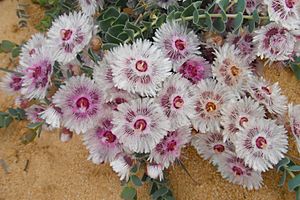Verticordia oculata facts for kids
Verticordia oculata is a beautiful flowering plant that belongs to the myrtle family, called Myrtaceae. You can only find it growing naturally in Western Australia. This plant is a sprawling, woody shrub. It has big, round leaves with white edges. Its flowers are silver-white with a dark center that looks lilac and purple. These are the biggest flowers in the Verticordia plant group! A famous plant scientist named Ferdinand von Mueller was amazed by its flowers in 1877. He even called it the 'princess of Australian flora'.
Quick facts for kids Verticordia oculata |
|
|---|---|
 |
|
| Scientific classification | |
| Genus: |
Verticordia
|
| Species: |
oculata
|
Contents
What Does Verticordia oculata Look Like?
Verticordia oculata is a shrub that usually grows between 20 and 70 cm (0.7 and 2 ft) tall. It can spread out to be 0.3–1.0 m (1–3 ft) wide. This plant has a special woody lump underground called a lignotuber. Many stems grow from this lignotuber.
Its leaves are almost perfectly round. They are about 4–11 mm (0.2–0.4 in) across. Each leaf has a clear white edge and attaches right to the stem without a stalk.
The flowers are quite large, about 20–25 mm (0.8–1 in) wide. They grow in a spread-out group at the top of the stems. Each flower sits on a stalk that is 7–11 mm (0.3–0.4 in) long.
The sepals (the leaf-like parts that protect the bud) are 9–10 mm (0.35–0.39 in) long. They are silver-white and look like feathers, with 12 to 14 deep divisions. At their base, they are lilac to purple. The petals (the colorful parts of the flower) are 7–8 mm (0.3–0.3 in) long and mostly round. They have 15 to 18 long, finger-like parts. Their color ranges from lilac-pink to purple. The way the flower parts are colored makes it look a bit like an eye. This plant usually blooms between October and December.
How Verticordia oculata Got Its Name
The first official description of Verticordia oculata was made in 1856 by a scientist named Carl Meissner. He studied a plant sample collected by James Drummond a few years earlier.
The second part of the plant's scientific name, oculata, comes from a Latin word. The Latin word oculus means "eye". The ending -atis turns it into an adjective, meaning "eye-like". This name was chosen because the dark colors in the center of the flower make it look like an eye.
Scientists believe that this plant and another species, Verticordia etheliana, once created a natural mix, called a hybrid. This hybrid was found but then lost in a bushfire. However, scientists were able to grow new plants from pieces of the original hybrid. This special hybrid is now known as Verticordia 'Wemms find'.
Where Verticordia oculata Lives
You can find Verticordia oculata growing alongside other plants from its genus (plant group). It likes to grow in heaths and shrublands, which are areas with low-growing shrubs. It prefers white, red, or yellow sand.
This plant lives in specific areas of Western Australia, including the Avon Wheatbelt, Carnarvon, Geraldton Sandplains, and Yalgoo regions. You can find it north of the Principality of Hutt River and as far inland as Yuna.
Is Verticordia oculata Protected?
The Western Australian Government's Department of Parks and Wildlife says that this verticordia plant is "not threatened". This means it is not currently at risk of disappearing.
Growing Verticordia oculata in Gardens
This small shrub has been called "spectacularly beautiful" because of its amazing look. Both Verticordia oculata and the hybrid Verticordia 'Wemms find' are great choices for gardening. Its branching shape, light-colored leaves, and big flowers are very attractive.
However, it's not very well known or grown outside of Western Australia. In Western Australia, some of these plants have grown successfully for over 14 years. You can start new plants from cuttings. But if grown on its own roots, it can sometimes get fungal diseases, especially in places with high humidity like Sydney. Plants that are already established in Western Australia can handle frost and heavy summer rain.

